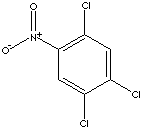PRODUCT IDENTIFICATION

201-931-7
CLASSIFICATION
PHYSICAL AND CHEMICAL PROPERTIES
liquid or solid depending on storage
REFRACTIVE INDEX
110 C
APPLICATIONS
- Monochlorobenzene ( MCB, CAS RN: 108-90-7)
- 1,2-Dichlorobenzene (1,2-DCB, CAS RN: 95-50-1)
- 1,3-Dichlorobenzene ( 1,3-DCB, CAS RN: 541-73-1)
- 1,4-Dichlorobenzene (1,4-DCB, CAS RN: 106-46-7)
- 1,2,3-Trichlorobenzene (1,2,3-TCB, CAS RN: 87-61-6)
- 1,2,4-Trichlorobenzene (1,2,4-TCB, CAS RN: 120-82-1)
- 1,3,5-Trichlorobenzene (1,3,5-TCB, CAS RN: 108-70-3)
- 1,2,3,4-Tetrachlorobenzene (1,2,3,4-TeCB, CAS RN: 634-66-2)
- 1,2,3,5-Tetrachlorobenzene (1,2,3,5-TeCB, CAS RN: 634-90-2)
- 1,2,4,5-Tetrachlorobenzene (1,2,4,5-TeCB, CAS RN: 95-94-3)
- Pentachlorobenzene (PeCB, CAS RN: 608-93-5)
- Hexachlorobenzene (HCB, CAS RN: 118-74-1)
Chlorobenzenes are white crystalline solids at room temperature while MCB, 1,2-DCB, 1,3-DCB, and 1,2,4-TCB, are clear liquids. They are practically insoluble in water and denser than water. The water solubility is decreasing if more chlorinated. The flammability of chlorobenzenes are low, the octanol/water partition coefficients are moderate to high, increasing with more chlorinated, and vapour pressures are low to moderate, decreasing with more chlorinated. The taste and odour thresholds are low, decreasing with lower chlorinated. MCB (which makes up more than 50 % of total production of all chlorobenzenes) and DCBs (more than 40 %) are prepared by the chlorination reaction of benzene in the liquid phase in the presence of iron(III) chloride. (the chlorination under strong illumination and without iron(III) chloride leads to benzene hexachloride instead of mono or polychlorobenzenes). The chlorination reaction for DCB leads to similar ratio of ortho- and para-dichlorobenzene, but small amount of the meta isomer is performed. The ortho and para isomers are separated by fractional freezing. While the para isomer crystallizes, the ortho isomer remains liquid. The meta-dichlorobenzene is prepared by heating and pressure with aluminum chloride. TCBs are obtained from the chlorination of appropriate chlorobenzene isomers in the presence of a Lewis acid catalyst. TeCBs are achieved by the addition of chlorine to trichlorobenzenes in the presence of an aluminium catalyst. PCB is produced by the denitrification of pentachloronitrobenzene and the reductive dechlorination of HCB as well as by the addition of chlorine to TeCB. HCB is produced by the direct chlorination of benzene with ferric chloride catalyst at 150-200 C from the distillation of residues from the production of tetrachloroethylene. Chlorobenzenes are used mainly as process solvents and solvent carriers as well as parent compounds in the synthesis of pesticides (mainly), plastics, dyes, pharmaceuticals and other organic compounds. They are used as insecticidal fumigants against moths, as space deodorizers, as general insecticides and fungicides on crops. They are used in metal treatments; in industrial deodorants; in cleaners for drains. Higher chlorinated benzenes of TCBs, TeCBs are used in dielectric fluids. 1,2,3-TCB is mainly used as a chemical intermediate and as a heat transfer fluid, a high boiling solvent, a dielectric fluid, insecticide and fungicide, coolant in electrical installation and glass tempering.
The prefix nitro- indicates the presence of NO2- radical, while nitrate refers to any salt or ester of nitric acid or the NO3- anion. Nitroso- is the prefix indicating presence of the group -NO and azo- is for -N=N- group. Some range of organic compounds containing nitrogen include nitro compounds (RNO2 ), nitroso compounds (RNO), amines (R3N ), amino acids, and natural alkaloids or nucleotides. The nitrogen ion in nitro compounds is trigonally planar with 120° angles. There are two resonance bonds so that the two oxygens are equivalent. Nitro compounds are strongly basic due to electron withdrawing both inductively and mesomerically. Historically, they are abundant in dyes and explosives. Nitro compounds, organic hydrocarbons having one or more NO2 groups bonded via nitrogen to the carbon framework, are versatile intermediate in organic synthesis.- Michael addition
- Reduction
- Henry Reaction (Nitro-aldol reaction)
- Nef reaction
- O-Alkylation
- Cycloaddition
- Substitution, Elimination, Conversion reaction
- Alkylation, Acylation, and Halogenation
1,2,4-Trichloro-5-nitrobenzene is used in making chemicals, insecticides and fungicides.
APPEARANCE
yellow semi solid
99.0% min
2811